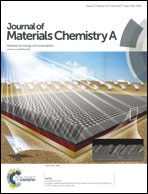Electrification based devices with encapsulated liquid for energy harvesting, multifunctional sensing, and self-powered visualized detection†
Abstract
Electrification between a solid and a liquid is a common but complex phenomenon which can both benefit and cause problems for industry, the laboratory, and our daily life. Here, utilizing this phenomenon, we designed a multifunctional device which can harvest vibration energy, sense mechanical/chemical changes, and intuitively detect wobble/leakage of liquid. Under low frequency, the device can generate room mean square voltages higher than 10 V and an average power of 0.9 μW, which is a great enhancement compared to previous liquid involved devices. Moreover, the device was demonstrated as a multifunctional active mechanical/chemical sensor for detecting the rotation and in situ measuring concentration in a specific range, and it has high stability due to the encapsulated environment. Finally, the device was utilized as a self-powered visualized system for detecting the wobble/leakage of the encapsulated liquid using itself as the energy source, which not only simplifies the measurement process, but also makes the total system power-free.


 Please wait while we load your content...
Please wait while we load your content...